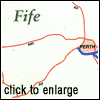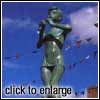|
Around Kirkcaldy
The town of Kirkcaldy developed from little more than
a single street stretching for 4 miles (6km) along the sea-front and thus became
known as the 'Lang Toun'. It has since expanded in most other directions and is now
the largest town in Fife with good motorway and rail-links to neighbouring communities
and beyond. The esplanade that shields the town's frontage from wild, winter North
Sea waves was built in 1922-23 to help alleviate a chronic shortage of employment.
This problem was further allayed when a local man, Michael Nairn, a sail cloth worker,
combined jute as a backing and linseed as a main surface ingredient to make a water-resistant
facing called linoleum.
 Today, in spite of a strong resurgence of the linoleum industry,
the town is trying to make the transition from an industrial to a service and tourist
based economy. Kirkcaldy is Fife's main shopping centre with the usual outlets lining
the High Street, but some of the side streets near the centre are worth exploring.
Facing the inner harbour, in an area known as the 'Sailor's Walk' is the oldest crow-stepped
house in Kirkcaldy, built around 1460. Kirk Wynd running down to the High Street
has several antique buildings, the most notable being Kirkcaldy's Old Kirk with its
admirable Norman tower. Today, in spite of a strong resurgence of the linoleum industry,
the town is trying to make the transition from an industrial to a service and tourist
based economy. Kirkcaldy is Fife's main shopping centre with the usual outlets lining
the High Street, but some of the side streets near the centre are worth exploring.
Facing the inner harbour, in an area known as the 'Sailor's Walk' is the oldest crow-stepped
house in Kirkcaldy, built around 1460. Kirk Wynd running down to the High Street
has several antique buildings, the most notable being Kirkcaldy's Old Kirk with its
admirable Norman tower.
For five days in April, Kirkcaldy's Esplanade is closed
off to traffic and accommodates the 'Links Market', the oldest and largest street
fair in Britain dating back to 1305. Today, waltzers, cyclone rides and burger stalls
dominate the scene but is a frenetic and colourful sight in the evenings.
Kirkcaldy is also the birthplace of Adam Smith, the
illustrious philosopher, political economist, pamphleteer and, in 1776, author of
the Wealth of Nations. The Adam Smith Theatre near the railway station puts on shows
and plays throughout the year, the main auditorium also being a cinema showing interesting
if sometimes dated films. There is a restaurant and bar and no further reference
to Adam Smith apart from his bust in the foyer.
The Kirkcaldy Museum and Art Gallery in War Memorial
Gardens next to the railway station captures the history and development of the 'Lang
Toun' quite well. It contains an interesting archaeological collection as well as
a display of the famous local Wemyss Ware pottery and a small art gallery with work
by Sir David Wilkie, Samuel Peploe, William McTaggart and Lowry.
One of Kirkcaldy's historic centre pieces has recently
been crowded by a modern housing development but nevertheless Ravenscraig Castle
towers dramatically above the shore-line at the east end of the town. Overlooking
the Firth of Forth, the ruin dates from 1460 when James II intended it for his first
wife. Flanking the castle are a flight of steps leading to the beach which inspired
the novelist John Buchan to write his novel The 39 Steps.
 Dysart, an eastern district of Kirkcaldy, is a little burgh
dating back to the sixteenth century. With enchanting wynds and courtyards, this
small corner of Fife is still full of character. Dysart was formerly a busy port
trading with the Netherlands. Some replica designs of the old fishing skiffs still
ply out into the Forth under a single sail. Dysart, an eastern district of Kirkcaldy, is a little burgh
dating back to the sixteenth century. With enchanting wynds and courtyards, this
small corner of Fife is still full of character. Dysart was formerly a busy port
trading with the Netherlands. Some replica designs of the old fishing skiffs still
ply out into the Forth under a single sail.
The Pan Ha' is a parade of seventeenth century houses
restored by Kirkcaldy District Council and the National Trust. Also restored was
the home of John McDouall Stuart. This house (now a museum) dates to 1575 and was
the nineteenth century explorers birthplace. He was the first man to cross Australia
from North to South in 1866. The Rectory Restaurant is situated behind St Serf's
Church and is an intimate yet informal place conscientiously run by its owners.
The two villages of East and West Wemyss lie side
by side to the east of Kirkcaldy and acquired their name from the many 'weems' or
caves found on this coast. Below McDuff's Castle, these remarkable caverns gave shelter
to man as far back as 2500BC. Now quite dangerous and damaged by vandalism, there
is a campaign to preserve them. Depicted inside is Britain's earliest picture of
a boat as well as various hunting scenes portrayed by craftsmen of Pictish times.
The most impressive is Court Cave, so named because
James IV once held court there, but now this and Well Cave are closed to the public.
The local tourist board advises the use of hard hats if you wish to enter Doo Cave
or Jonathan's Cave. The ruined McDuff's Castle in East Wemyss was the stronghold
of the Thanes of Fife and reputed to be the home of 'MacDuff' in Shakespeare's MacBeth.
Little now remains of this castle.
 Although commenced in the 1950s, Glenrothes is still sometimes
referred to as one of Scotland's group of seven 'new towns'. It was originally intended
to meet the housing needs of Fife's colliery workers but that industry declined soon
after the town was commissioned and it subsequently turned its economical attention
to more modern industries such as electronics. Although commenced in the 1950s, Glenrothes is still sometimes
referred to as one of Scotland's group of seven 'new towns'. It was originally intended
to meet the housing needs of Fife's colliery workers but that industry declined soon
after the town was commissioned and it subsequently turned its economical attention
to more modern industries such as electronics.
There is little to see in Glenrothes unless you are
interested in rather uninspired 'sixties' architecture. A prehistoric henge monument,
however, at Balfarg is worth seeking out as well as the restored stone circle of
Balbirnie on either side of the A92 about 1 mile north of Glenrothes. Balbirnie Country
Park with a craft centre and attractive 18-hole parkland golf course is situated
in the nearby village of Markinch.
|



